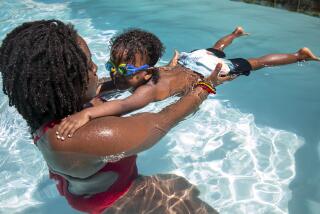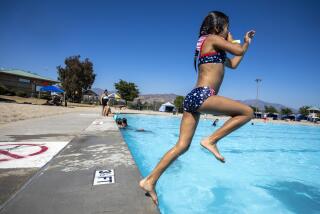Vacationers can make a splash without becoming a statistic
- Share via
AT first glance, the vacation places predicted to be the most popular this year seem disparate. New York’s on the list. So are Cabo San Lucas, Mexico, and Honolulu.
But look again at the list, compiled annually by Carlson Wagonlit Travel Associates after polling its member owners and agents, and you’ll see a common denominator in many of its 20 most popular locales: water.
Many vacationers want to play in the water: to swim, scuba dive, snorkel, wade, go boating.
Excuse me for being a spoilsport, but there’s a danger many don’t think about at that waterside resort: drowning.
Worldwide, about 449,000 people drown each year, the World Health Organization says.
But drowning is mostly preventable, according to a team of researchers that just published a list of 29 recommendations for water safety and drowning prevention in a recent issue of the Journal of Travel Medicine.
Which regions pose the drowning risk for travelers?
“They are the regions that you would suspect -- the Caribbean, Mexico, Central America, Oceania -- destinations one would associate with beaches,” says Leslie Cortes, former assistant director of the Injury Research Center at the Medical College of Wisconsin in Milwaukee, and a co-author of the paper on water safety.
Among the team’s safety recommendations:
* Check advisories issued by such organizations as WHO or the federal Centers for Disease Control and Prevention about dangerous water conditions.
* Take a life jacket for yourself and your companions. Don’t figure your destination will have one, says Dr. Stephen W. Hargarten, director of the Injury Research Center. Look for devices that have the Coast Guard-approved label.
* Before you leave, brush up on your swimming and cardiopulmonary resuscitation skills, or take a boating course.
* Stay in hotels with safety fences around the pools if you are traveling with children.
* Avoid alcoholic beverages during water activities. If you do imbibe, limit consumption to one drink. “Drinking and swimming is no different than drinking and driving, particularly if you are in unfamiliar surroundings,” Hargarten says.
Scuba divers should take a few extra safety measures:
* Take a course that is certified by a reputable organization, says Jeff Myers, a spokesman for the Divers Alert Network, a safety and medical research organization associated with Duke University Medical Center. Several organizations certify divers, he says, including the Professional Assn. of Diving Instructors, the National Assn. of Underwater Instructors, and Scuba Schools International.
* Check out the equipment on board before you get on. “Do they have first-aid supplies, oxygen, maybe even an automatic external defibrillator?” Myers asks. “Talk to them about what they would do if there is a dive emergency.”
* Ask how they know which divers are in the water, Myers says. They may do a roll call, listing divers on a sheet of paper, or they may put a tag on divers going in the water and ask them to return it when they get back on board, then display it on a board.
* “If you have not been in the water for a while, six months or so, seek a refresher course,” Myers says.
Greg Stockton, a health and safety expert with the American Red Cross in Washington, D.C., has additional advice: Watch for the dangerous “toos” -- too tired, too cold, too far from safety, too much sun (which saps your energy), too little hydration and too much strenuous activity.
*
Kathleen Doheny can be reached at kathleendoheny@earthlink.net.
More to Read
Sign up for The Wild
We’ll help you find the best places to hike, bike and run, as well as the perfect silent spots for meditation and yoga.
You may occasionally receive promotional content from the Los Angeles Times.





